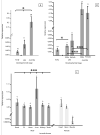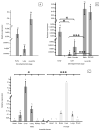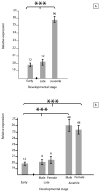Sex-biased expression of sex-differentiating genes FOXL2 and FGF9 in American alligators, alligator Mississippiensis
- PMID: 23689672
- PMCID: PMC3798014
- DOI: 10.1159/000350787
Sex-biased expression of sex-differentiating genes FOXL2 and FGF9 in American alligators, alligator Mississippiensis
Abstract
Across amniotes, sex-determining mechanisms exhibit great variation, yet the genes that govern sexual differentiation are largely conserved. Studies of evolution of sex-determining and sex-differentiating genes require an exhaustive characterization of functions of those genes such as FOXL2 and FGF9. FOXL2 is associated with ovarian development, and FGF9 is known to play a role in testicular organogenesis in mammals and other amniotes. As a step toward characterization of the evolutionary history of sexual development, we measured expression of FOXL2 and FGF9 across 3 developmental stages and 8 juvenile tissue types in male and female American alligators, Alligator mississippiensis. We report surprisingly high expression of FOXL2 before the stage of embryonic development when sex is determined in response to temperature, and sustained and variable expression of FGF9 in juvenile male, but not female tissue types. Novel characterization of gene expression in reptiles with temperature-dependent sex determination such as American alligators may inform the evolution of sex-determining and sex-differentiating gene networks, as they suggest alternative functions from which the genes may have been exapted. Future functional profiling of sex-differentiating genes should similarly follow other genes and other species to enable a broad comparison across sex-determining mechanisms.
Copyright © 2013 S. Karger AG, Basel.
Figures



Similar articles
-
RNA-seq analysis of the gonadal transcriptome during Alligator mississippiensis temperature-dependent sex determination and differentiation.BMC Genomics. 2016 Jan 25;17:77. doi: 10.1186/s12864-016-2396-9. BMC Genomics. 2016. PMID: 26810479 Free PMC article.
-
Cloning and expression analysis of two ZFY-related zinc finger genes from Alligator mississippiensis, a species with temperature-dependent sex determination.Gene. 1992 Oct 1;119(2):221-8. doi: 10.1016/0378-1119(92)90275-t. Gene. 1992. PMID: 1398103
-
Chromosomal and temperature-dependent sex determination: the search for a conserved mechanism.J Exp Zool. 1994 Sep 15;270(1):112-6. doi: 10.1002/jez.1402700112. J Exp Zool. 1994. PMID: 7931128
-
Foxl2 and Its Relatives Are Evolutionary Conserved Players in Gonadal Sex Differentiation.Sex Dev. 2016;10(3):111-29. doi: 10.1159/000447611. Epub 2016 Jul 22. Sex Dev. 2016. PMID: 27441599 Review.
-
Can Xenobiotics Alter the Sex Ratio of Crocodilians in the Wild?Sex Dev. 2021;15(1-3):179-186. doi: 10.1159/000515724. Epub 2021 Jun 23. Sex Dev. 2021. PMID: 34161954 Review.
Cited by
-
Effects of Temperature on the Expression of Two Ovarian Differentiation-Related Genes foxl2 and cyp19a1a.Front Physiol. 2018 Sep 25;9:1208. doi: 10.3389/fphys.2018.01208. eCollection 2018. Front Physiol. 2018. PMID: 30356866 Free PMC article.
-
Did Lizards Follow Unique Pathways in Sex Chromosome Evolution?Genes (Basel). 2018 May 3;9(5):239. doi: 10.3390/genes9050239. Genes (Basel). 2018. PMID: 29751579 Free PMC article. Review.
References
-
- Bull JJ. Evolution of sex-determining mechanisms. Benjamin/Cummings; California, USA: 1983.
-
- Clinton M, Zhao D, Nandi S, McBride D. Evidence for avian cell autonomous sex identity (CASI) and implications for the sex-determination process? Chromosome Res. 2012;20:177–190. - PubMed
-
- Colvin JS, Green RP, Schmahl J, Capel B, Ornitz DM. Male-to-female sex reversal in mice lacking fibroblast growth factor 9. Cell. 2001;104:875–889. - PubMed
Publication types
MeSH terms
Substances
Grants and funding
LinkOut - more resources
Full Text Sources
Other Literature Sources
Research Materials

